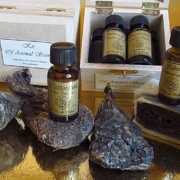Thoughts from Timbuktu – fixatives
Our customs change as generations pass but the words of our language remain, some of them taking a different meaning or even becoming misleading.
A century ago perfumes were largely used on handkerchiefs, scarves and gloves rather than on the skin as they are today.
There is a big difference between thinking about “the perfume is my dress” and “the perfume is myself”.
“The perfume that is myself” is worn on the skin and becomes part of one’s body, while “the perfume that dresses me” is worn on the clothes that dress us.
The animal pheromones originally used in perfumery are designed by nature to be long-lasting. They are territorial sexual pheromones that male animals leaves on territory in order to draw a boundary for other males and at the same time seduce females of their species.Being fragrant, they are perfumes by all effects and these aromatic chemical compounds have been designed not only to resist time but also bad weather, sun, cold, and rain.
They have the characteristics of emanating pure sensuality territorial sexual pheromones and of being extremely persistent. The double advantage for the perfumers of the past who made lavish use of them. Liked by the animals (certainly evolved) that we are and able to give fragrances durability that is synonymous with quality, these are the pheromones of original perfumery; Civet, Castoreum, Ambergris, bee’s wax, Hyraceum, muskdeer, etc…
There is one problem though.
Pheromones have been created by the animal kingdom to be squirted on the rocks, trees, leaves, but not on the human skin.
The animal fixative that functioned so well for the perfumes sprayed on handkerchiefs does not make anything for the modern perfume worn on the skin.
Castoreum, Civet, and others last much less than patchouli or ylang-ylang on our neck or our wrists.
In spite of this, the fixative myth, cultivated with care by fragrances’ manufacturers, protracts until these days.
And yet Guy Robert, the famed composer of Madame Rochas, Diorissimo, and many other renowned perfumes, says: “The durability of a perfume is not easy to achieve, and nobody knows how to do it. I hate and find stupid the idea of fixatives.” (Google: Guy Robert “Biogenesis of a perfume”)
Still, synthetic musk, Ambroxan or Cetalox, (so-called synthetic ambers), or even chemical Castoreum have exceptional durability on the skin, like Calone and other molecules of the laboratory. Why? It is simply due to their incompatible nature with the human body. Disposed off with difficulty by the organism, they willingly accumulate in the natural filters of the body, skin, brain, liver, kidneys, and so on, with easily deducible consequences.
These new molecules, mainly inexistent in nature, have durability, but not fixative properties. The fixation of a perfume, so difficult to obtain and so mysterious according to Guy Robert, permits the whole scent to protract in time. In a manner of speaking, it binds the elements together, while synthetic molecules only last longer than the rest of the perfume, thus becoming entirely the flat bottom of the fragrance – the only smell that remains after some hours.
In order to go back to the pure joy of wearing perfumes that are not outrageously invading or persistent until nausea, we should perhaps return to the philosophy of “the perfume that dresses me” instead of “the perfume that is myself”, and start using more natural perfumes, wearing them on our dresses instead of our skin?
We could think that much more is requested to a scent that has to emanate the essence of our personality than to a scent that has just to dress our personality. It should be first of all completely exclusive because every person is completely different from all others. But in reality, it is not so at all, perfumes are mass production items.
This is why fashion manufactures stereotypes, epochal archetypes to not say seasonal ones, in which each can identify himself not as a unique and unrepeatable person, but as a member of a club, a cast, an elite, a group.
The model proposed is always the same – seduction, luxury, and sex. A rather reduced vision not only of the perfume itself, but above all of being a human.
The advertising of perfumes often seems to have been conceived by a team of philosophically hermaphrodite cocaine addicts.
Our philosophical models change as our customs change and the result for our perfumes is that they are becoming more and more like chemical soups sold in a strike of media-psycho persuasion.
The housewife gets convinced to wear a perfume in order to feel like the young beautiful slim model in the advertising.
The model is a very unique person, but the perfume is a mass product that will be worn by millions of individuals.
Before you realize that instead of attracting the opposite sex your perfume acts as a repellent to persons with good taste, a hundred new fragrances made to seduce just for another season will be advertised in order to keep alive the fraud of “the perfume that is myself”.
Perhaps should we return to the original philosophy of “the perfume that dresses me”, maybe just to be able to choose a different model than one of “seduction, luxury and sex” that has become the “one way thought” of modern perfumery.























Leave a Reply
Want to join the discussion?Feel free to contribute!